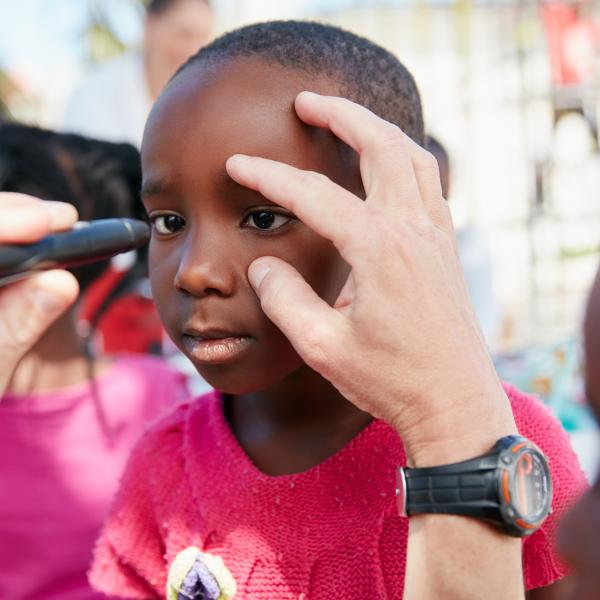What is CVI?
Cerebral visual impairment (sometimes called cortical visual impairment or CVI) is a disorder caused by damage to the parts of the brain that process vision. It’s most common in babies and young children, but can continue into adulthood.
A child with CVI has vision problems that are caused by their brain that can’t be explained by a problem with their eyes. Normally, the eyes send electrical signals to the brain, and the brain turns those signals into the images you see. If you have CVI, your brain has trouble processing and understanding these signals.
CVI is a leading cause of vision loss among kids in the United States. For some children with CVI, vision gets better over time, but everybody is different. If your child has CVI, make sure that they get early intervention and therapy, educational support, and other special services to help them develop and learn.
What are the symptoms of CVI?
CVI can cause a variety of visual problems that can range from mild to severe. Kids with CVI may have trouble:
- Responding to the things they see
- Seeing certain parts of what is in front of them, like busy moving scenes
- Recognizing faces and objects
- Recognizing things in cluttered spaces
- Reaching for something while they’re looking at it
- Understanding what they’re looking at
Parents may also notice that their child with CVI:
- Reacts slowly to visual cues
- Prefers to look at things that are moving
- Prefers to look at things in a certain part of their vision, like with their peripheral (side) vision
Some kids with CVI tend to stare at light (like lamps or the sun), while others are sensitive to light.
Kids with CVI often have other disabilities or health problems, including:
- Developmental disabilities
- Cerebral palsy (a brain disorder that causes movement problems)
- Epilepsy (a brain disorder that causes seizures)
- Hearing loss
What causes CVI?
CVI is caused by an injury to the brain. Most of the time, these injuries happen before, during, or shortly after birth. Common causes of CVI in babies and young children include:
- Lack of oxygen or blood supply to the brain — often because of a stroke
- Hydrocephalus (when fluid builds up in the brain)
- Infections that reach the brain
- Head injury
- Certain genetic conditions
Babies who are born prematurely (early) are more likely to have CVI.

Can adults get CVI?
Adults can also develop problems with their vision after a traumatic brain injury (such as a head injury or stroke that damages the brain). Veterans may be at higher risk for visual problems as a result of combat injuries.
These problems are sometimes called acquired CVI, but it isn’t the same as CVI. A brain injury that happens later in life usually has different symptoms than CVI, which is caused by an injury early in life.
If you or a loved one has vision problems because of a brain injury, ask the doctor about vision rehabilitation and other support services. Vision rehabilitation can help people with brain injuries make the most of their vision.
How will my child’s eye doctor check for CVI?
There’s no single test to check for CVI. If you suspect that your child has vision problems, the first step is getting a comprehensive eye exam to see if the problem is with their eyes.
If the exam doesn’t find eye problems that explain your child’s symptoms, that might mean the problem is with their brain. To get diagnosed, your child will need to see an eye doctor who’s familiar with CVI. Your child may need to visit other specialists like a pediatric neurologist or neuro-ophthalmologist.
The doctor will examine your child and ask about their medical history. They may also order scans of your child’s brain.
CVI can be hard to diagnose, but the right diagnosis is key to getting your child the help they need. So if your child has vision problems that can’t be explained by a problem with their eyes or fixed by glasses, ask your doctor if it could be CVI — especially if your child has had a brain injury.
What’s the treatment for CVI?
There’s no cure for CVI, but vision rehabilitation can help people with CVI make the most of their vision. For some people with CVI, vision problems get better over time on their own. Experts aren’t sure why this happens.
Babies and kids with CVI need early intervention and therapy, educational support, and other special services to help them develop and learn. Learn more about early intervention.
If your child has CVI, it’s important to work together with their doctors to find the best plan for their care. Some kids may need treatment for other health conditions they may have besides CVI.
What’s the latest research on CVI?
NEI funds research to better understand and treat CVI. One NEI-funded research team is creating a virtual reality (VR) tool and using brain imaging to help scientists better understand how people with CVI process vision compared with people who have problems with their eyes. Other scientists are coming up with new methods to test vision in infants and young children. This research could help improve vision rehabilitation for CVI.
